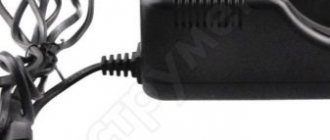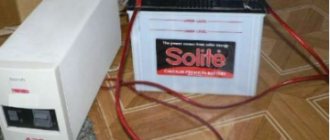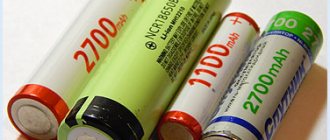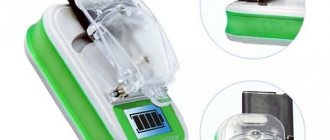Using sunlight to charge batteries has long ceased to be a subject for science fiction books and is effectively used in the modern world. Using a solar charger, you can easily charge MP3 players, laptops, cell phones and smartphones, which can be very useful in situations of sudden power outages or being away from electrical sources.
The solar charger is very easy to use: just place it in direct sunlight and connect the gadget and the portable device will charge.
Principle of operation
Its operating principle is quite simple: sunlight falls on a special panel, which absorbs it, after which the energy is processed by the device into electric current and supplied to the built-in power source.
Such devices have a number of advantages: they are silent, environmentally friendly, durable, do not require fuel and generate electricity for free.
Varieties
If you decide to buy an external solar charger, you should first decide where you plan to use it.
It could be:
- Charging mobile phones , smartphones and other handheld devices. To recharge your phone in case of force majeure, the smallest charger will be enough for you, but if you want to use all the capabilities of your mobile devices away from civilization, then you should choose a charger with a higher battery capacity.
- Charging laptops or tablets. For tablets with an output voltage of 5 V, almost any device is also suitable, but with power-hungry laptops it is more difficult - when buying a charger, you need to make sure that the output voltage is not lower than the voltage of your laptop. At the same time, charging will be able to restore the energy of a smartphone, camera, etc.
- Chargers for summer cottages and campsites. The most powerful of chargers with built-in AC outlets that can power household or medical equipment.
Chargers are also available with and without a battery. If you have a battery, the converted solar energy charges it, after which it charges your gadgets. In its absence, the sun's rays, being transformed, directly charge the equipment.
Device diagram
A solar battery with a working size of 4x4 cm charges the battery through a VD1 diode of type D311. It prevents the battery from discharging at times when the solar panel's lighting is low and its voltage drops below the battery voltage. Diode VD1 should be germanium with the lowest possible voltage drop in the forward direction. In bright sunlight, this battery produces an EMF of about 3 V, which is a lot for one Ni-Mh battery. To reduce the voltage on the battery, the VD2 LED is connected in parallel to it. This LED should be selected so that it opens at a voltage of 1.6 - 1.8 V. The battery is placed in a plastic block for galvanic cells of AA size.
Criterias of choice
So, you need a solar charger - how to choose the best option in terms of price and quality?
To do this you need to follow simple instructions:
- Study the technical specifications of the charger and compare them with the parameters of the gadgets you are going to charge.
- Check the compatibility of the charger connectors and the connected devices, as well as the presence of additional plugs and adapters.
- Explore additional features and choose the ones that suit you. Many models are equipped with a built-in flashlight; devices with Bluetooth function and even a radio receiver are available.
- Enjoy the compact design, weight and ease of use and portability.
- Decide on the appearance and design of the device. There are also various options for charging based on the operation of solar batteries: in a rigid case, flexible, shockproof, waterproof, as well as devices with a buffer battery.
- Choose the one that suits your price. It is worth considering that the main pricing factor is the power of the device.
Solar charging for lithium battery
“I molded him from what was” (c) Tanich M.
My good old friend is a water tourist. Once upon a time, back in the last century, as my son says, I gave a friend a solar battery to charge the batteries of a video camera.
Then I bought five domestically produced solar cells from Chip and Deep, connected them in series, and added a KD213 diode. The result was a battery with a voltage of about 9 volts and a current of about 300 mA. Mechanically, the battery elements were connected by strips of blue electrical tape, the battery folded like an accordion, my friend made a homemade case for it. 15 years have passed since then, this battery has been on hikes many times and has always successfully charged a variety of Ni-Cd batteries.
Now it is fashionable to use lithium power supplies both for photo and video devices and for LED flashlights. Everything is great, but lithium cells require careful handling - they must be carefully charged to a voltage of 4.2 volts, discharged to a certain voltage, otherwise you can irreversibly damage the battery or start a fire.
On a hike, my friend takes a headlamp with 18650 batteries. There is no charging mechanism in such a flashlight, so he asked me to figure out how to charge these elements while hiking. Along the way, there is the task of recharging smartphones and other gadgets. I studied the offers on Ebay.com and found an interesting device - a battery with a capacity of 10,000 mAh, in the same case with a solar battery and electronics that control the charge and discharge of the battery and provide a voltage of 5 volts at a current of up to 2A on two USB connectors. The price of 1000 rubles seemed adequate, the device was ordered. Device name: Solar Panel Power Bank Charger Battery for Mobile Samsung Iphone5s HTC 10000mAh
I also found a charger for 18650, consisting of an excellent holder case and a charging controller built into the USB connector. It cost about 80 rubles. This item is called New USB 18650 Battery Function Charger.
The original idea was that on a sunny day the Power bank would charge the internal battery and then send the energy to the 18650 via charging.
Quite quickly, both devices arrived from China and I began to study them. Charging for the 18650 did not present any surprises - an excellent case, charges the 18650 with a capacity of 2400 mAh from the USB port with a current of about 300 mA.
But the PowerBank turned out to be defective. I measured its capacity by completely discharging it with a constant current of about 300 mA - it turned out to be 1200 mAh. With the declared 10,000 mAh it’s a deception.
However, the case was made very well! Metal lids, everything fits together, it feels like a single whole in your hands. I decided to take it apart and see what was inside.
Inside there was quite high-quality electronics - a lithium cell charging controller board combined with a 5 volt 2 A converter-stabilizer. It was not possible to install all types of microcircuits, but the impression was that the board was made for a multi-cell lithium battery with individual control of the charge and discharge of each element. However, all this wealth remains unused; the lithium cells are simply connected in parallel. By the way, the soldering of this battery fell apart literally from touching it with a soldering iron... I then looked at the elements separately - IMHO, an outright defect...
The 5 volt converter is made on a modern microcircuit operating at a frequency of 500 kHz.
At the same time, I measured the maximum output current - it turned out to be 1.6A. With the stated 2A – quite adequate.
The photo shows the discharge circuit. Wirewound variable resistor 33 ohms, two parallel connected resistors of 2 ohms (1 ohm in total) to control the discharge current.
Since the PowerBank has a 5 V stabilizer, it is enough to set the current consumption once at the beginning of the experiment. The board also has an LED indicator of the battery charge level, which works in both discharging and charging modes. As usual, it’s a bright, eye-catching blue color.
In general, everything is good, except for the battery.
I contacted the seller and demanded that part of the money be returned for the defective battery. The seller tried to confuse me with an allegedly incorrect method for measuring capacity - they say I did not take into account the losses, but after my second letter, where I sorted everything out, I returned part of the money.
Since I disassembled the PowerBank, I decided to try how it would work with an 18650 and an old solar battery. The results of the full-scale experiment turned out to be quite encouraging: the controller worked completely normally with 18650, and the 15-year-old solar battery provided a charging current of about 370 mA. The measurement was carried out in Moscow on March 10. I believe that the summer Sun will provide an even greater charge current.
The charge-discharge current was measured by installing a 0.1 ohm resistor in series in the battery circuit. The 0.1 ohm resistor in my case consisted of two 0.2 ohms connected in parallel. The voltage drop across this resistor was measured with a multimeter. The current was converted from millivolts to milliamps by multiplying by 10.
I measured the current given by the original solar cell - it turned out to be significantly lower, however, quite expected - the surface area is much smaller.
Thus, the optimal design began to look like a holder for 18650, a cut-off case with a board, and a separately connected solar battery. The 18650 holder has a pin connector; I cut off the mating part from the USB connector and soldered it to the solar panel. There are 4 wires coming out of the 18650 holder - two from the battery itself and two from the solar cell. This time the electrical tape was used in black, the blue one has served for 20 years and is in excellent condition, let's see how the black one behaves.
A couple of hours with a Dremel, a drill and a pair of shears gave me this design:
Fully assembled:
The result is a system that can charge 18650 from a 5 volt source (USB) and a solar battery, and can supply a stable 5 volts to charge a variety of gadgets; fortunately, the PowerBank kit included several adapters. A glitch has emerged - if the device is left without a battery for a long time, it does not turn on from the button. It turned out that the glitch gets around if you remove and insert the battery once or twice.
Now this device will be tested on the next trip to the Eastern or Western Sayan Mountains or some other exotic place in Russia.
Important points of use
When using a solar charger, there are a few things you should know to help you get the most out of your device and extend its life.
The performance of a solar battery can be affected by factors such as:
- Panel area. With a larger area of energy, more energy is generated.
- Cell type. Polysilicon and monocrystalline elements have the highest performance.
- Cloudy conditions increase the time it takes for the battery to accumulate energy.
- If the panel is not positioned correctly in relation to the sun, this can also significantly reduce the speed. You can choose the most favorable location for the panel using a miniature light intensity indicator; in its absence, the general rule applies: a vertical panel location is better than a horizontal one.
- To constantly recharge the device you need, you can attach the charger to your backpack. But do not forget that it will only work in direct sun in open areas - it will be of no use in the forest.
- The charging time of the connected gadget is determined by the power output of the battery.
- Charging time using a photocell is shorter than when using conventional charging from the electrical network.
- When using a charger based on solar panels, you should control the temperature: it is not advisable to overheat it - on a too hot day, it is advisable to periodically remove the charger in the shade. Also, too high (or low) a temperature level can significantly reduce the battery capacity.
- During storage, it is advisable to recharge the battery from time to time to avoid increasing the static discharge coefficient.
- Before you start using the charger, it is recommended to carry out a training cycle 2-3 times (fully charge - completely discharge).
How to make it yourself
Some prefer an alternative option, such as making a solar battery charger yourself, especially since it is not so difficult, expensive and interesting.
Tools
To make a solar battery charger with your own hands, you will need the following tools:
- tweezers;
- pliers;
- glue gun;
- blowtorch;
- knife.
Materials
Also prepare the following materials:
- 5V or greater solar panel;
- 3.7 V lithium-ion battery;
- battery charge monitoring circuit;
- DC boost circuit (USB);
- two 2.5 mm connectors – one with panel mounting, the second with a wire;
- diode 1N4001;
- the wire.
And auxiliary materials for the design: insulating tape, heat-shrinkable tubes (preferably), double-sided foam tape, solder, box (tin or any suitable one).
Stages of work
Having prepared everything you need, you can start making a solar battery charger with your own hands.
The manufacturing stages are as follows:
- Connecting the wire.
- Preparing holes for connectors in the housing.
- Connecting a charge controller.
- Connecting the battery and USB circuit.
- Careful insulation of wires.
- Placement of electronic components in the housing.
If you've made your own solar charger, you know that it can also be charged by sunlight or via a mini USB port. The LED should light up red during charging and blue when charging is complete.
Now you can not only choose the optimal charging option, but also know how to make a charger from a solar battery that will help you save electricity and not be left without communication and other conveniences of modern technology in extreme situations, or just on vacation.
How does the protection board work?
The TP4056 board contains two LEDs: red and blue. The first one turns on during the battery charging process, the second one - after it is completely charged. There is also a mini-USB connector for charging the battery. You can solder the charging device to the places marked on the board BAT+ and BAT-. The input voltage during the battery charging process should be in the range from 4.5 to 5.5 V.
You can purchase the TP4056 board in one of two options. The first one is with a protective block, the second one is without a protection module. The charging current for both boards is 1A.
It is recommended to use a circuit board for soldering circuit boards, as they get very hot. The printed circuit board should be raised by making special legs from rigid wire. It is preferable to take copper. If there is no copper wire, then pin connectors can be used instead.











